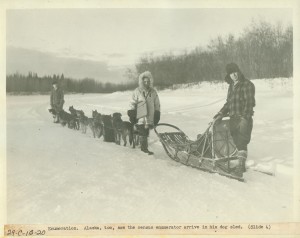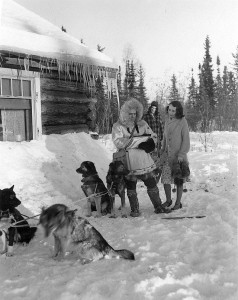 The use of dog sleds by census enumerators continued through the 1940 census. Photo courtesy of the U.S. National Archives (https://www.flickr.com/photos/usnationalarchives/6935831853/)
The use of dog sleds by census enumerators continued through the 1940 census. Photo courtesy of the U.S. National Archives (https://www.flickr.com/photos/usnationalarchives/6935831853/)
The United States Federal Census is among the most frequently utilized resources of genealogical researchers. However, rarely do we stop and consider the difficulties faced by enumerators in obtaining the data that we value so dearly. Never was the plight of census takers more apparent or severe than during the early decades of the twentieth century, when a number of men were charged with surveying the population of the Alaskan Territory.
Unlike the other forty-four states, where the census was taken on 15 April 1900, in Alaska enumerators began surveying the population as early as July 1899, and certain areas were not counted until October 1900, a span of fifteen months.[1] This was due largely to the fact that the Territory had a population density of 0.1 persons per square mile, as compared to the United States as a whole, which had a population of 30.4 persons per square mile.[2] The population density for Alaska equated to an area of 9.2 square miles per inhabitant.[3]
The methods utilized by census enumerators to obtain their data was often times reminiscent of an action film. For instance, in the Supplement to the 1910 Census, the tale of one individual identified only as “Enumerator No. 12” is told. This enumerator, who was traveling through his district by dog sled, got caught in a blinding snowstorm for more than three days. After racing to the isolated camp which served as the team's goal, the enumerator recorded the data for the camp on scrap paper before retracing his 200-mile journey for more supplies.[4]
Certain coastline areas could not support larger boats, and as a result census agents utilized three-holed animal skin boats known as “bidarkies.”[5] Another challenge faced by enumerators was counting the large non-English speaking indigenous population of Alaska. According to the 1910 supplement, census taking for the native population was largely done by teachers during the Christmas holiday, as this is when a majority of the population was home.[6] Adding to census takers’ difficulties was the fact that many of the natives did not know their age in terms of years. One enumerator recalled that most indigenous people could recall a significant event from their childhood and could identify that they were “as big as that” while pointing to a child of a known age.[7] Furthermore, natives did not utilize a system of months; instead, they identified months in terms of events such as the month of “sea otter hunting” (April), the month of “mak[ing] gardens” (May), the month of “first berries ripen[ing]” (July) and the month of “first snow-about” (October).[8]
All of these factors led to a lot of interesting cases and omitted information. For instance, as seen above, one enumerator recorded a household headed by 104 year old Natekok (born in an unknown month in 1795) and her 69-year-old daughter, as well as a 3-year-old daughter.[9] It is in situations such as this that language barriers become clear.
In the end, the work done by census enumerators in Alaska in the early twentieth century should be appreciated by historians and genealogists. The challenges faced by census takers was perhaps best summarized by the writer of the 1910 supplement, who concluded: “That the service lost none of the men from freezing to death, and that every man returned safely, is a matter of congratulation and good fortune.”[10]
Notes
[1] Census.gov. “Supplement for Alaska: Population, Agriculture, Manufacturers, Mines and Quarries” (1910), http://www2.census.gov/prod2/decennial/documents/41033927n358-359ch10.pdf, p. 567.
[2] Ibid., p. 575.
[3] Ibid.
[4] Ibid., p. 569.
[5] Ibid., p. 570.
[6] Ibid., p. 568.
[7] Ibid.
[8] Ibid.
[9] Household of Natekok, 1900 United States Federal Census, Alaska, Household 185.
[10] "Supplement for Alaska," p. 570.
Share this:
About Zachary Garceau
Zachary J. Garceau is a former researcher at the New England Historic Genealogical Society. He joined the research staff after receiving a Master's degree in Historical Studies with a concentration in Public History from the University of Maryland-Baltimore County and a B.A. in history from the University of Rhode Island. He was a member of the Research Services team from 2014 to 2018, and now works as a technical writer. Zachary also works as a freelance writer, specializing in Rhode Island history, sports history, and French Canadian genealogy.View all posts by Zachary Garceau →
